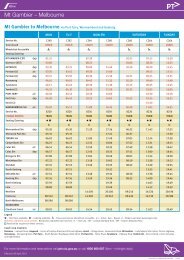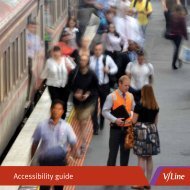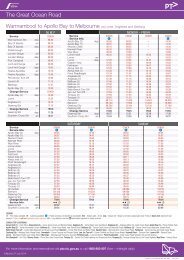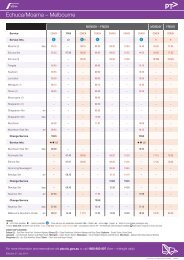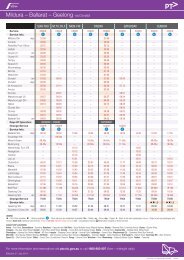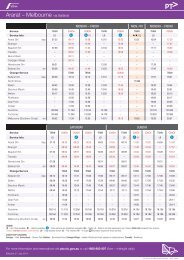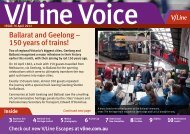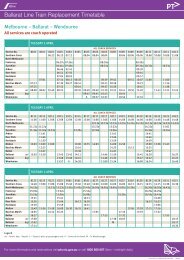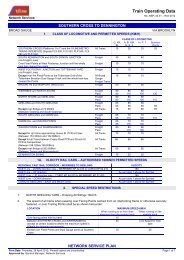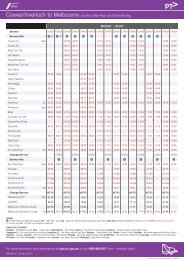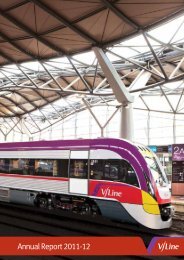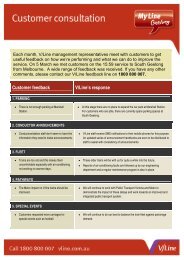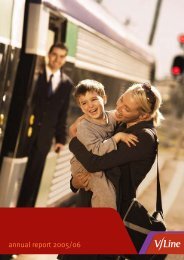ANNUAL REPORT 2004â05 - V/Line
ANNUAL REPORT 2004â05 - V/Line
ANNUAL REPORT 2004â05 - V/Line
- No tags were found...
Create successful ePaper yourself
Turn your PDF publications into a flip-book with our unique Google optimized e-Paper software.
NOTES TO THE FINANCIAL STATEMENTS(i) InventoriesInventory consists of fuel used in rolling stock. It is valued at the monthly average cost.(j) Revaluations of non-current assetsRolling stock is measured at fair value and all other non-current assets are measured at cost.Revaluations are made with sufficient regularity to ensure that the carrying amount of each asset does not differ materially from its fairvalue at the reporting date.Revaluations are assessed annually and supplemented by independent assessments, at least every three-years. Revaluations areconducted in accordance with the Victorian Government Policy - FRD 6A Application of Victorian Government Policy “Revaluation ofNon-Current Physical Assets”.(k) Investment in SubsidiariesInvestment in subsidiaries are carried at fair value. Where these investments exceed the net asset position of the subsidiary, the carryingvalue is written down to the net asset position.(l) Cost and valuation of property, plant and equipmentValuation of Rolling StockIn the prior year, V/<strong>Line</strong> Passenger Pty. Ltd revised its accounting policy in relation to the valuation of rolling stock. The prior yearvaluation was performed by rolling stock specialists and reviewed by a qualified valuer. Although valuation of assets is typically based onthe net recoverable value as per AASB 1010, the company has used depreciable replacement cost as a valuation basis. This valuation isin keeping with FRD 6A, which clarifies that a net recoverable test does not apply to a not-for-profit entity, since there is no dependenceon its assets abilities to generate net cash inflows, consequently the carrying amount should reflect the remaining ability to provideservices.(m) Depreciation of property, plant and equipmentDepreciation is provided on a straight-line basis on all plant and equipment, including rolling stock. It is calculated at rates to allocate thecost less estimated residual value at the end of the useful lives of the assets against revenue over the shorter of the estimated usefullives, or alternatively the remaining lives of the relevant asset to the consolidated entity.Rolling stock comprises locomotives, carriages, diesel multiple units (known as Sprinters) and vans. Any refurbishments or conversionsare depreciated over the remaining life of the original asset.Major depreciation periods are (unchanged from 2004):Leasehold improvementsPlant and equipmentRolling Stock(including components)(n) Leasehold improvements3 to 10 years3 to 10 years2 to 40 yearsThe cost of improvements to or on leasehold properties is amortised over the unexpired period of the lease or the estimated useful life ofthe improvement to the consolidated entity whichever is the shorter. Leasehold improvements held at the reporting date are beingamortised over 3 to 10 years (2004 - 3 to 10 years).(o) Leased non-current assetsLeases are classified at their inception as either operating or finance leases based on the economic substance of the agreement so as toreflect the risks and benefits incidental to ownership where appropriate.Operating LeasesThe minimum lease payments of operating leases, where the lessor effectively retains substantially all of the risks and benefits ofownership of the leased item, are recognised as an expense on a straight-line basis.Operating lease payments are charged to the statement of financial performance in the periods in which they are incurred, as thisrepresents the pattern of benefits derived from the leased assets.V/LINE <strong>ANNUAL</strong> <strong>REPORT</strong> 2004-05|49



